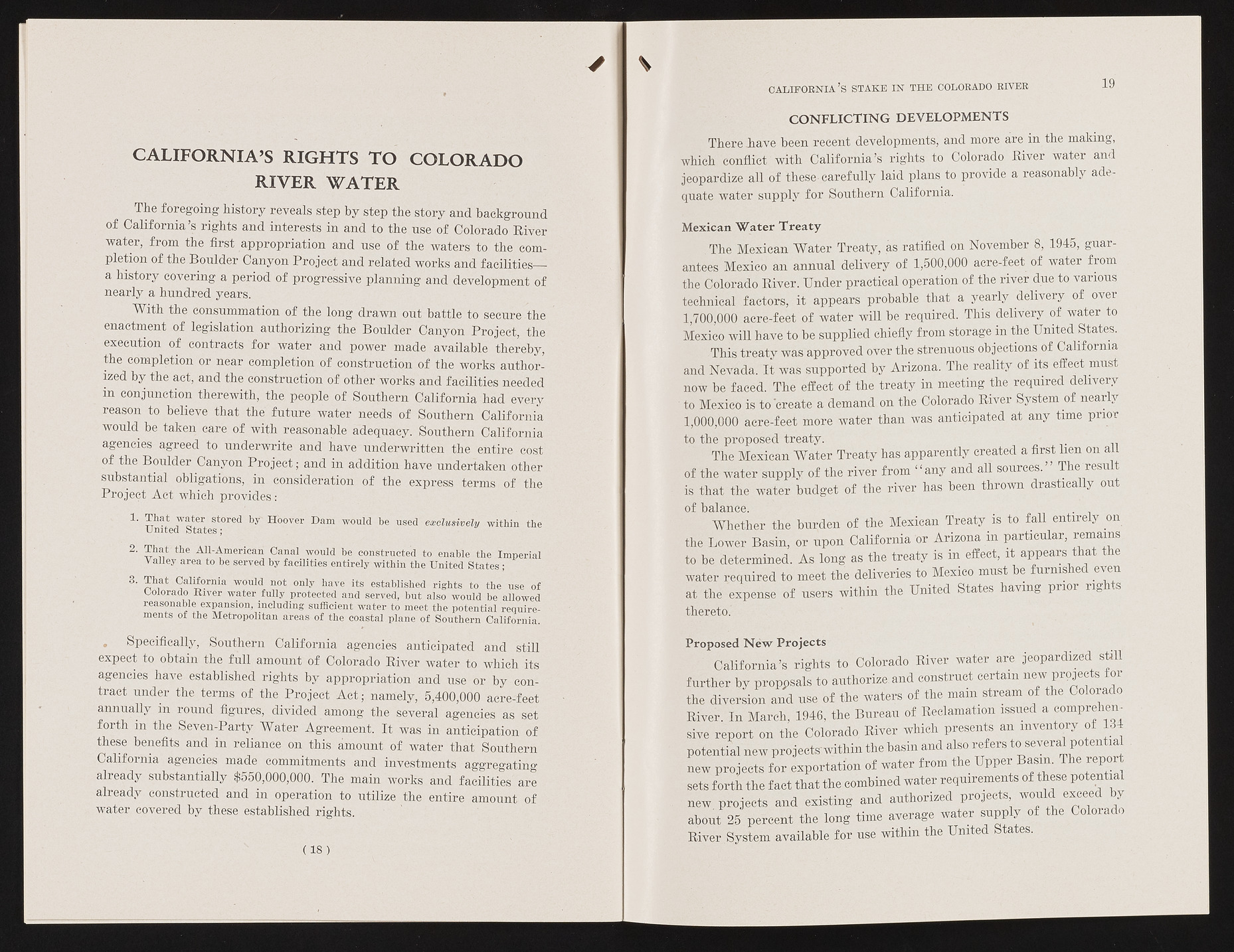Copyright & Fair-use Agreement
UNLV Special Collections provides copies of materials to facilitate private study, scholarship, or research. Material not in the public domain may be used according to fair use of copyrighted materials as defined by copyright law. Please cite us.
Please note that UNLV may not own the copyright to these materials and cannot provide permission to publish or distribute materials when UNLV is not the copyright holder. The user is solely responsible for determining the copyright status of materials and obtaining permission to use material from the copyright holder and for determining whether any permissions relating to any other rights are necessary for the intended use, and for obtaining all required permissions beyond that allowed by fair use.
Read more about our reproduction and use policy.
I agree.Information
Digital ID
Permalink
Details
Member of
More Info
Rights
Digital Provenance
Publisher
Transcription
CALIFORNIA’S RIGHTS TO COLORADO RIVER WATER The foregoing history reveals step by step the story and background of California’s rights and interests in and to the use of Colorado River water, from the first appropriation and use of the waters to the completion of the Boulder Canyon Project and related works and faeiRtieJSf a history covering a period of progressive planning and development of nearly a hundred years. With the consummation of the long drawn out battle to secure-the enactment of legislation authorizing the Boulder Canyon Project, the execution of contracts for water and power made available thereby, the completion or near completion of construction of the works authorized by the act, and the construction of other works and facilities needed in conjunction therewith, the people of Southern California had every reason to believe that the' future water heeds of Southern California would be taken care of with reasonable adequacy. Southern California agencies agreed to underwrite and have: underwritten the entire cost' of the Boulder Canyon Project; and in addition have undertaken other substantial obligations,pin consideration of the express terms of the Project Act which provides : : .feT bat water stored by Hoover Dam would be used exclusively within the l.nued States; ' ' ? ??''? " ? 2. That-the All-American Canal would be constructed to enable the Imperial Valley area to be served by facilities entirely within the United States ; 3. That California would not only have itg'-established rights to the use of Colorado River Water fully protected iind served, but also would be allowed reasonable expansion, including sufficient water to meet the potential requirements of the Metropolitan areas of the coastal plane of Southern California, Specifically, Southern California agencies anticipated and still expect, to obtain the full amount of Colorado River water to which its agencies have established rights by appropriation and use or by -eon-tract under the terms of the Project A c t; namely, 5,400,000 acre-feet annually in round figured, divided among the several agencies as set forth in the Seven-Party Water Agreement. It was in anticipation of these benefits and in reliance on this amount of water that Southern California agencies made Commitments and investments aggregating already substantially $550,000,000. The main works and facilities'are already constructed and in operation to utilize the entire amount of • water covered by these established rights. (18) CALIFORNIA’ s STAKE IN THE COLORADO RIVER 19 CO N FLIC TIN G DEVELOPMENTS There Rave been recent developments, and more are in the making, which conflict with California’s rights to Colorado River water and jeopardize all of these carefully laid plans to provide a reasonably adequate water supply for Southern California. Mexican W ater Treaty The Mexican Water Treaty, as ratified on November S, 1945, guarantees Mexico an annual delivery of 1,500,000 acre-feet of water from the Colorado River. Under practical operation of the river due to various; technical factors, it appears probable that a yearly delivery of over 1,700,000 acre-feet of water will he required. This delivery of water to Mexico will have to he supplied chiefly from storage in the United States. This treaty was approved over the strenuous objections of California and Nevada. It was supported by Arizona. The reality of its effect must now be faced. The effect of the treaty in meeting the required delivery to Mexico is to'create a demand on the Colorado River System of nearly 1,000,000 acre-feet more water than was anticipated at any time prior +.n flip ?nvnTw'vciprl Ltpjlfw The Mexican Water Treaty has apparently created a first lien on all of the water supply of the river from “ any and all sources. The resu t. is that the water budget of the river has been thrown drastically out of balance. Whether the burden o f the Mexican Treaty is to§a ll entirely on the Lower Basin, or upon California or Arizona in particular, remains to be determined. As long as thltreaty is in effect, it appears that the water required to meet the deliveries to Mexico must he fuM shed even at the^xpense of users within the United States having prior rights thereto.’ Proposed N ew Projects C?California’s rights to Colorado River wafer atgjeopardized still further by proppsals to authorize and construct certain ? T O E H the diversion and use of the waters of the main stream :of the Colorado River. In March, 1946, the Bureau of Reclamation issued a compre cn-sive reporUon the Colorado. River which presents an inventory of 134 potential new projects'with in the basin and also refers to^everal poten la new pro j i t s for exportation of water from the Upper B as*. The report sets forth the fact that the combined water requirements of these potential new projects and existing and authorized! projects, would exceed by about 25 percent the long time average water supply of the Colorado River .System avail a b le > r use within the United States,

